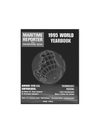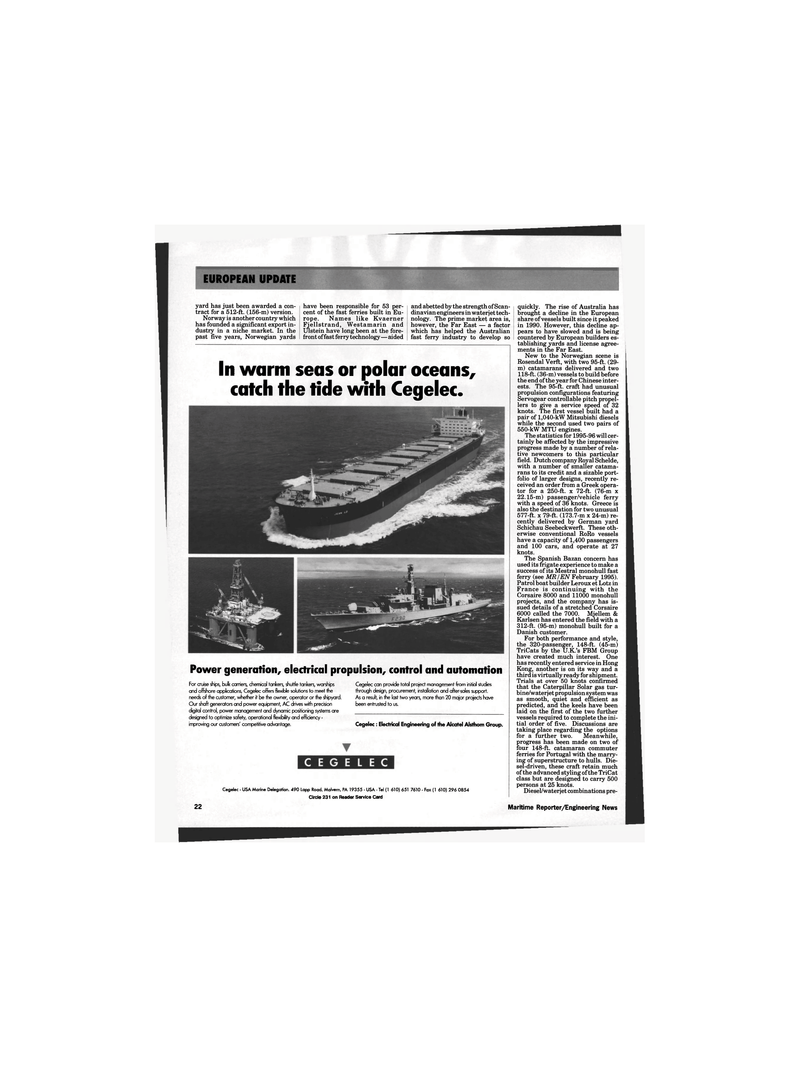
Page 20: of Maritime Reporter Magazine (June 1995)
Read this page in Pdf, Flash or Html5 edition of June 1995 Maritime Reporter Magazine
EUROPEAN UPDATE
Power generation, electrical propulsion, control and automation
For cruise ships, bulk carriers, chemical tankers, shuttle tankers, warships and offshore applications, Cegelec offers flexible solutions to meet the needs of the customer, whether it be the owner, operator or the shipyard.
Our shaft generators and power equipment, AC drives with precision digital control, power management and dynamic positioning systems are designed to optimize safety, operational flexibility and efficiency - improving our customers' competitive advantage.
Cegelec can provide total project management from initial studies through design, procurement, installation and after-sales support.
As a result, in the last two years, more than 20 major projects have been entrusted to us.
Cegelec : Electrical Engineering of the Alcatel Alsthom Group.
Cegelec - USA Marine Delegation. 490 Lapp Road, Malvern, PA 19355 - USA - Tel (1 610) 651 7610-Fax (1 610) 296 0854
Circle 231 on Reader Service Card quickly. The rise of Australia has brought a decline in the European share of vessels built since it peaked in 1990. However, this decline ap- pears to have slowed and is being countered by European builders es- tablishing yards and license agree- ments in the Far East.
New to the Norwegian scene is
Rosendal Verft, with two 95-ft. (29- m) catamarans delivered and two 118-ft. (36-m) vessels to build before the end of the year for Chinese inter- ests. The 95-ft. craft had unusual propulsion configurations featuring
Servogear controllable pitch propel- lers to give a service speed of 32 knots. The first vessel built had a pair of 1,040-kW Mitsubishi diesels while the second used two pairs of 550-kW MTU engines.
The statistics for 1995-96 will cer- tainly be affected by the impressive progress made by a number of rela- tive newcomers to this particular field. Dutch company Royal Schelde, with a number of smaller catama- rans to its credit and a sizable port- folio of larger designs, recently re- ceived an order from a Greek opera- tor for a 250-ft. x 72-ft. (76-m x 22.15-m) passenger/vehicle ferry with a speed of 36 knots. Greece is also the destination for two unusual 577-ft. x 79-ft. (173.7-m x 24-m) re- cently delivered by German yard
Schichau Seebeckwerft. These oth- erwise conventional RoRo vessels have a capacity of 1,400 passengers and 100 cars, and operate at 27 knots.
The Spanish Bazan concern has used its frigate experience to make a success of its Mestral monohull fast ferry (see MR/EN February 1995).
Patrol boat builder Leroux et Lotz in
France is continuing with the
Corsaire 8000 and 11000 monohull projects, and the company has is- sued details of a stretched Corsaire 6000 called the 7000. Mjellem &
Karlsen has entered the field with a 312-ft. (95-m) monohull built for a
Danish customer.
For both performance and style, the 320-passenger, 148-ft. (45-m)
TriCats by the UK's FBM Group have created much interest. One has recently entered service in Hong
Kong, another is on its way and a third is virtually ready for shipment.
Trials at over 50 knots confirmed that the Caterpillar Solar gas tur- bine/waterjet propulsion system was as smooth, quiet and efficient as predicted, and the keels have been laid on the first of the two further vessels required to complete the ini- tial order of five. Discussions are taking place regarding the options for a further two. Meanwhile, progress has been made on two of four 148-ft. catamaran commuter ferries for Portugal with the marry- ing of superstructure to hulls. Die- sel-driven, these craft retain much of the advanced styling of the TriCat class but are designed to carry 500 persons at 25 knots.
DieselAvaterjet combinations pre- yard has just been awarded a con- tract for a 512-ft. (156-m) version.
Norway is another country which has founded a significant export in- dustry in a niche market. In the past five years, Norwegian yards have been responsible for 53 per- cent of the fast ferries built in Eu- rope. Names like Kvaerner
Fjellstrand, Westamarin and
Ulstein have long been at the fore- front of fast ferry technology—aided and abetted by the strength of Scan- dinavian engineers in waterjet tech- nology. The prime market area is, however, the Far East — a factor which has helped the Australian fast ferry industry to develop so
In warm seas or polar oceans, catch the tide with Cegelec. 22 Maritime Reporter/Engineering News

 19
19

 21
21
